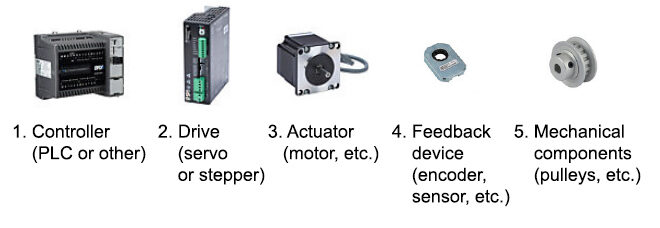 Cookies are not enabled on your browser.
Cookies are not enabled on your browser.Cookies are required for our site. Please enable cookies in your browser preferences to continue.
We will close at 3PM ET on Tuesday, December 23rd. Please note our shipping changes for Tuesday.
Freight shipments, FedEx ground and customer pickup deadline is 11:00AM ET. FedEx Priority (and free 2-day delivery) cutoff will be 1:00 PM ET. No UPS shipping will be available on Tuesday.
Drop ship vendors, Saginaw, Husky and Weigmann will also be closed Friday, Dec 26th.
Merry Christmas to each of you and your families from the employees of AutomationDirect
- Barcode / RFID / Vision
- Bulk Wire & Cable
- Cables (Terminated)
- Circuit Protection / Fuses / Disconnects
- Communications
- Drives & Soft Starters
- Enclosure Thermal Management & Lights
- Enclosures & Racks
- Field I/O
- HMI (Human Machine Interface)
- Hydraulic Components
- Motion Control
- Motor Controls
- Motors
- Pneumatic Components
- Power Products (Electrical)
- Power Transmission (Mechanical)
- Process Control & Measurement
- Programmable Controllers
- Pushbuttons / Switches / Indicators
- Relays / Timers
- Safety
- Sensors / Encoders
- Stacklights
- Structural Frames / Rails
- Tools & Test Equipment
- Valves
- Water (Potable) Components
- Wire & Cable Management
- Wire & Cable Termination
- Retired Products
Configuration Utilities
- PLC Family Selector
- P1000 PLC Systems
- P2000 PLC Systems
- P3000 PLC Systems
- ProductivityCODESYS
- CLICK PLC Systems
- Do-more® BRX PLC Systems
- LS-Electric® XGB PLC Systems
- Productivity®Open Systems
- Datalogic® Safety Light Curtains
- LS-Electric® Servo Systems
- Nitra® Pneumatic Grippers
- Object Detection (Sensors)
- PAL Controller Configurator
- Precision Gearbox Selector
- Protos X® Field I/O
- Pyrometers Selector
- Quadritalia® Modular Enclosures
- Stellar® Soft Starters
- Stepper System Selector
- SureFrame T-slot Extrusion
- SureMotion® XYZ Gantry
- SureServo2® System Selector
- SureStep® Linear Actuators
- Timing Belts & Pulleys
- Werma® Stacklights
- ZIPLinks
Motion Control In Depth
Motion Control encompasses the devices and methods used to control the movement of mechanical systems. It involves the use of diverse technologies and multiple components to accurately position, align, or move objects in a controlled and coordinated way.
Motion control systems typically consist of:
- The controller or the "brain" of the system, which handles all the calculations and timing of the desired movements.
- Drive systems are used to amplify or convert the signals from the controller and transmit them to the actuator.
- Actuators are devices, including motors, cylinders, etc., that perform the actual movement based on the received electrical signals
- Feedback sensors provide data on the system's position, velocity, or acceleration to the control system for better accuracy.
- Other mechanical components can be utilized to modify the torque, speed, direction, etc. of the motion, including gears, pulleys, and belts.

Motion control is a vital part of industrial automation and is used in many applications, including:
- Industrial robots
- CNC machines
- Conveying systems
- Assembly lines
- Pick-and-place systems
Motion controllers have advanced considerably over the years with the two predominate methods of controlling motion being via hardwired pulsed signals, commonly referred to as pulse and direction control, or through Ethernet communication, namely EtherCAT. Both methods offer advantages and disadvantages, as seen below, but AutomationDirect offers considerable cost savings no matter which method you prefer.
EtherCAT was created by Beckhoff Automation and released in 2003 as a solution to the limitations of existing fieldbus technologies for real-time control applications. Using Ethernet media, EtherCAT can achieve extremely fast data transfer rates, with low latency, ensuring fast and reliable real-time communication between multiple devices.
- Control method: a high-performance Ethernet-based fieldbus protocol for precise motion control
- Topology: ring or star topology
- Data transmission: frame-based communication with a distributed clock
- Latency: extremely low latency, making it suitable for real-time applications
- Synchronization: precise synchronization between nodes
- Applications: robotics, factory automation, and machine tools
- Advantages: high speed, low latency, flexible, and scalable
- Disadvantages: higher initial cost compared to pulse/direction control
- Best used for high-performance motion systems
Pulse and direction control has been used for many decades and continues to be applied in various industries. In basic terms, this method controls the speed and direction of a motor or other mechanical device by applying pulses of electrical energy.
- Control method: a simple and cost-effective method for controlling motors using pulsed discrete signals
- Topology: point to point
- Data transmission: pulse/direction signals, with polarity determining direction of motion and frequency determining speed
- Latency: higher latency using conventional I/O
- Synchronization: limited
- Applications: less demanding applications like simple conveying systems
- Advantages: low cost and operational simplicity
- Disadvantages: limited accuracy, lower speed, and potential issues with coordination
- Best used for simple applications with cost limitations and/or lower speed/accuracy requirements
Check out our job openings
Free Online PLC Training
FREE Video Tutorials
FREE e-Newsletter
Automation Notebook
Product Literature
White Papers
News, Product and Training Bulletins
E-Books
 Safe &
Secure
Safe &
Secure

We accept VISA, MasterCard, Discover, American Express, PayPal or company purchase orders.
Voted #1 mid-sized employer in Atlanta
Check out our
job openings

